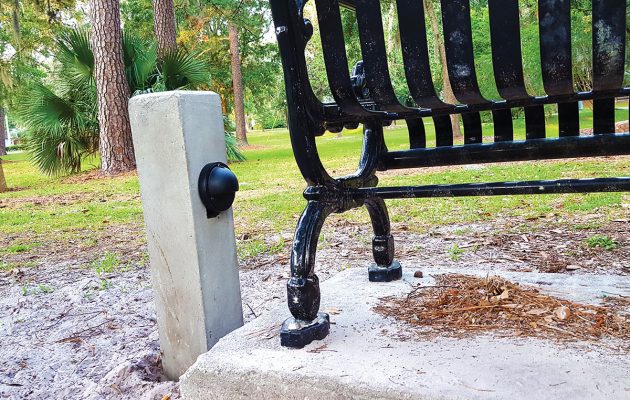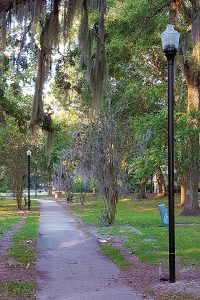Local preservation society donates funds to illuminate park

Although some Ortega residents were in the dark about new lights being installed in Cortez Park, the illumination project, which was partially funded by the Ortega Preservation Society, has received mostly positive reviews by the community.
While objections came from a few residents who stated anonymously they preferred the “passive” nature of the park and said lighting would drive out night birds, others have expressed excitement over the lights as they often walk their dogs in the park at night.
“In no way to be unsympathetic to anyone that is opposed to the project, concern had been raised over the years by those that walk in the evenings as to how dark the park was,” said Harrison Conyers, a board member of the Ortega Preservation Society, via email.
According to City Spokesperson Tia Ford, the society donated $11,000 toward the cost of the $19,872 project. It was submitted to the City of Jacksonville approximately a year ago.
The project consists of four single-pole lights – matching the traditional lamp posts along Ortega Boulevard – to be installed along the sidewalk which bisects the circular park. According to Ford, they will be LED lights with a “soft” illumination. There will also be three small low-level bench lights installed next to each of the benches, Ford said.
The project began in mid-April and was completed about four weeks later.
This effort was not the first time the preservation group took an interest in restoring the historic community, which dates back to the time of the American Revolution, when Colonel Daniel McGirtt moved into the Jones Plantation and served with rebel troops in Georgia against the British.
“In 1999, we led a major enhancement project in Ortega Village, which was suffering from a severe case of urban blight,” said Dr. Richard Hardin, OPS president. “This cost about $400,000. Councilman [James] Overton contributed $100,000 in Renaissance bond money. OPS raised over $60,000 and First Guaranty Bank matched up to $50,000 of that $60,000 that was raised. The remainder was given by the city and was from various in-kind contributions.”
The Village renovation was thought of as an extension of Cortez Park, said Hardin, noting they would have added period lighting in the park at that time, but because of lack of funds or resources, it was not done.
“With OPS having funds currently and no active projects, several board members thought that adding the lights to the park would finish off the project we had in the Village almost 20 years ago and would better serve the pedestrian traffic through the park on the sidewalk in the evening,” Hardin said. “The two tall street lights that light the park seemed inadequate and clearly do not fit the decor of the adjacent Village the way the new period lights will.
“This decision was not taken to the neighborhood because it was felt, after discussion with Parks & Recreation, that lighting would be improved without being too bright, and the park would better be tied to the Village with the period lights,” he said.
Cortez Park is one of four circular parks created in the early 1990s along what is now Baltic Street. The other three are Bettes Park (formerly Ponce de Leon Park), DeSoto Park, and Columbus Park.
Conyers was instrumental in restoring Columbus Park 10 years ago when, as a board member of the Ortega Preservation Society, he directed the facelift. The park, which is seen by many as the front door to Old Ortega from U.S. 17/Roosevelt Boulevard, received curbing around its perimeter to prevent parking on the lawn, as well as a new sidewalk, benches, and decorative trash receptacles. In addition, a brick wall was erected at the entrance to denote Ortega as a National Historic District. At that time, the preservation society donated $15,000 toward the $45,000 project.
By Kate A. Hallock
Resident Community News







